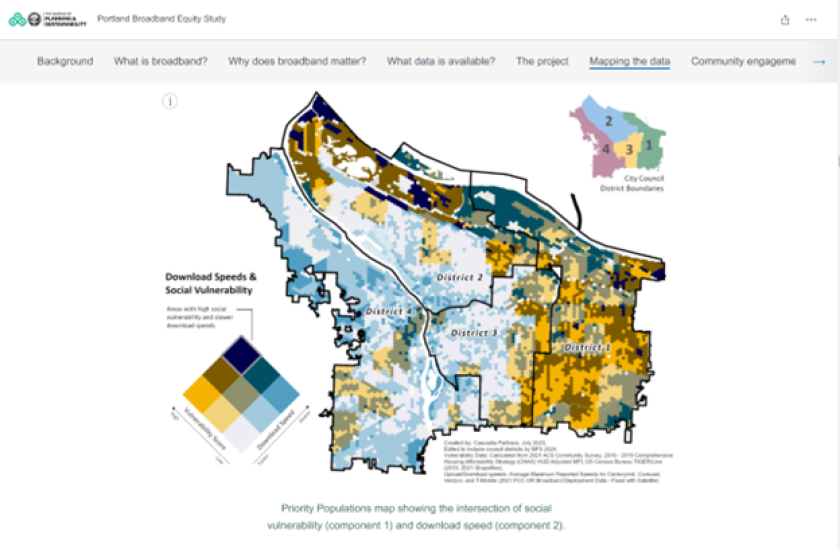- Portland Broadband Story Map
- NDIA Launches Affiliate Map
- Utah Libraries Launch Digital Collection
- Broadband Legislation Roundup
- Asheville Buses Get Wi-Fi
PORTLAND BROADBAND STORY MAP
Last week, the city of Portland’s Bureau of Planning and Sustainability launched the Broadband Equity Study Story Map. This interactive resource aims to help users visualize Internet access disparities in the city by combining data analysis with residents’ experiences.
The map aims to do several things. First, it seeks to identify populations that are consistently impacted by limited Internet access. Second, it maps geographic areas that are at greater risk of experiencing prolonged lack of an Internet connection. Third, it highlights key themes from community insights to inform policy. Fourth, it attempts to bolster Portland’s efforts to secure funding for broadband affordability initiatives.
“This tool will help guide our digital equity efforts and ensure we are advocating for policies that truly meet the needs of Portlanders,” Seema Gadh Kumar, the city’s chief of community technology, said in a statement.
In part, this tool aims to highlight the gaps in connectivity that are not displayed on the national Federal Communications Commission National Broadband Map. The national map designates the majority of Portland as “served,” meaning it is less likely to receive federal funding investments. According to the city’s announcement, that map “does not capture the reality of Portland’s connectivity issues.”

The story map details that households earning $50,000 or less annually are paying more than $100 per month for Internet, a cost greater than that of any other income bracket. One of the themes that emerged through this study is that while affordability is critical, it is not the only issue hindering adoption; device access and education also create barriers.
The Portland Broadband Equity Project was initiated as a result of insights revealed in the city’s 2022 Digital Equity Issue Brief. The project aimed to identify priority populations and geographical areas and themes, all of which inform targeted digital inclusion efforts. The project also aimed to expand funding source opportunities for the city.
The city encourages residents to explore the story map to learn more.
NDIA LAUNCHES AFFILIATE MAP
In other map-related news, the National Digital Inclusion Alliance (NDIA) has unveiled an interactive Affiliate Map to simplify connections between members. The map, powered by Esri, includes search filters and view options.
There are currently more than 2,000 NDIA affiliates in 50 states, the District of Columbia, American Samoa, the Commonwealth of the Northern Mariana Islands, Guam, Puerto Rico, the U.S. Virgin Islands, and in 41 tribal entities. If an update is needed to an organization’s information on the map, NDIA is accepting emails at community@digitalinclusion.org.

Nonprofit organizations and government entities at the state, local, tribal or federal level that are in the U.S., the District of Columbia, or U.S. territories and are involved in digital inclusion work can become an affiliate, with both free or paid membership options available.
UTAH LIBRARIES LAUNCH DIGITAL COLLECTION
In other state news, the Utah State Library partnered with Gale to provide free access to digital resources for the state’s more than 3 million residents. Expanded access to reliable content will help Utah public libraries better support the learning needs of the communities they serve.
The materials include literature, vehicle repair instruction, multidisciplinary databases, peer-reviewed journals, entrepreneurship information, and health and wellness resources. State residents can access these digital resources at any time using a library card.
Per a statement from State Librarian of Utah Cara Rothman, the partnership aligns with the Utah State Library’s “commitment to support lifelong learning of all Utahns, which is essential for personal and professional growth,” and the partnership is expected to be impactful for rural Utahns with limited access to library services.
BROADBAND LEGISLATION ROUNDUP
Several pieces of federal legislation related to broadband and digital equity were introduced, or reintroduced, in the last week. One bill addresses the federal Broadband Equity, Access and Deployment (BEAD) program.
First, the Precision Agriculture Satellite Connectivity Act was reintroduced, which aims to help U.S. farmers incorporate technology into their operations. This bill builds on previous legislation that expanded access to rural broadband for farmers.
Next, the bipartisan Promoting United States Wireless Leadership Act of 2025 aims to convene trusted technology leaders to participate in global standards-setting for 5G and future wireless communications network generations.
Additionally, the Streamlining Program Efficiency and Expanding Deployment (SPEED) for BEAD Act was introduced by Republican members of the Subcommittee on Communications and Technology, of the House Energy and Commerce Committee. The BEAD program’s future path has been unclear following an executive order from the Trump administration, but this legislation aims to improve the program “to ensure timely and accessible deployment,” per an announcement. Notably, the BEAD program’s current 10-year timeline was already written into law by Congress, BEAD Program Director Evan Feinman previously emphasized to Government Technology.
A March 5 statement from U.S. Secretary of Commerce Howard Lutnick on the BEAD program details that the Commerce Department has launched a review of the program, with a goal of “ripping out the Biden Administration’s pointless requirements.” The statement indicates that a “revamped BEAD program” will move forward following review.
Because the program was written into law by Congress, its director underlined that to “faithfully execute those laws” is the job of civil servants.
“There is broad bipartisan support against any pause or overhaul of the BEAD program,” said a statement from the Communications Workers of America, arguing that the National Telecommunications and Information Administration can offer flexibility through waivers for states, without delaying the states ready to award funds and start building.
ASHEVILLE BUSES GET WI-FI
In local news, the city of Asheville, N.C., has made free Wi-Fi available for use on all its Asheville Rides Transit (ART) buses. The service is made possible through a partnership and grant funding from Land of Sky Regional Council and Dogwood Health Trust.
ART Wi-Fi service is available on all bus routes. Users must select the network named with ART and their corresponding bus number and accept the terms of service to get connected. The service is part of the city’s commitment to improve the public transportation experience. More information about ART and its schedule can be found on the city’s website.
Asheville is not alone in its decision to make Wi-Fi available on public transit; Los Angeles County launched a similar effort in 2017.









